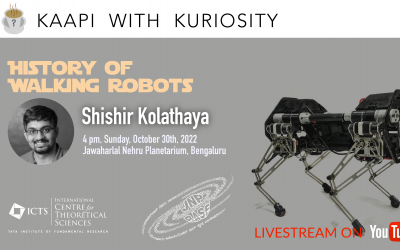Abstract:
In the 1870’s Leland Stanford, then governor of California, commissioned Eadweard Muybridge to find out whether or not a trotting horse left the ground with all four feet at the same time. Muybridge went on to document the walking and running behavior of over 40 mammals. In 1893 Lewis A. Rygg devised and patented a technique to control a mechanical horse by using pedals. In 1960’s the GE developed a mechanical quadruped, with each limb strong enough to push a car. In late 1980’s Marc Raibert at MIT made remarkable hopping machines that performed all kinds of stunts, from hopping to flipping to jogging. In 1991, Tad McGeer developed the concept of passive walking for bipedal robots, focusing entirely on the mechanical design that yielded stable walking behaviors on an inclined plane. The more recent contributions to walking include the ASIMO from Honda, the PETMAN & Spot robots from Boston Dynamics, Digit from Agility Robotics, and several types of quadrupeds (four-legged) from numerous companies like Unitree Robotics, ANYbotics, Ghost robotics.
Walking over the decades has been studied in several different ways, each of them showing varying degrees of successes and failures. The first half of the presentation will contain a detailed analysis of some of these methods. It is important to understand that we are still a long way from the real-life deployment of these legged robots. We need faster generation of walking gaits, more dynamic behaviours, and more robustness. Therefore, the second half of the presentation will focus more on the tools used to bring these kinds of robots to the next level. Specifically, we will use concepts like trajectory optimization for fast generation of walking trajectories, model predictive control (MPC) for real-time tracking, and reinforcement learning (RL) techniques for the realization of emergent behaviours. These will be demonstrated on multiple robotic platforms including a custom-built quadruped robot called Stoch 3.
About the Speaker:
Shishir is an Assistant Professor of the Robert Bosch Centre for Cyber Physical Systems (RBCCPS) and the Department of Computer Science and Automation (CSA) in IISc Bangalore. He received his Ph.D. degree in Mechanical Engineering (2016) from the Georgia Institute of Technology, M.S. degree in Electrical Engineering (2012) from Texas A&M University, and B.Tech. degree in Electrical Engineering (2008) from the National Institute of Technology Karnataka, Surathkal. He is the PI of Stochastic Robotics Lab at IISc. Shishir started his career in the field of robotics, especially in the domain of legged robots. His primary focus as a PhD student was on stability and control of walking robots. He has diversified to other fields like safety-critical control, and machine learning for all kinds of robotic platforms.



